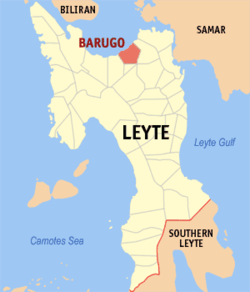Barugo, Leyte
| Barugo | |
|---|---|
| Municipality | |
 Map of Leyte with Barugo highlighted |
|
| Location within the Philippines | |
| Coordinates: 11°19′N 124°44′E / 11.317°N 124.733°ECoordinates: 11°19′N 124°44′E / 11.317°N 124.733°E | |
| Country | Philippines |
| Region | Eastern Visayas (Region VIII) |
| Province | Leyte |
| District | 2nd district of Leyte |
| Barangays | 37 |
| Government | |
| • Mayor | Alden M. Avestruz |
| Area | |
| • Total | 84.62 km2 (32.67 sq mi) |
| Population (2015 census) | |
| • Total | 32,745 |
| • Density | 390/km2 (1,000/sq mi) |
| Demonym(s) | Barugonon |
| Time zone | PST (UTC+8) |
| ZIP code | 6519 |
| IDD : area code | +63 (0)53 |
| Income class | 4th municipal income class |
| 083706000 | |
| Electorate | 19,489 voters as of 2016 |
| Website | www |
Barugo is a 4th class municipality in the province of Leyte, Philippines. According to the 2015 census, it has a population of 32,745 people.
Residents of the town of Barugo are traditionally referred to as Barugonon but often incorrectly referred to as Barugueños.
Barugo is a town in the northern coastal part of Leyte facing Carigara Bay, 50 kilometres (31 mi) north-west of Tacloban City, whose history dates back to the early days of Spanish colonization. It remains an agricultural town producing rice, corn and copra. Residents of a few coastal barangays are engaged in small-scale fishing and aquaculture. Its cottage industries are the manufacture of tuba (coconut palm wine) and roscas (sweet pastries made of flour, sugar, eggs and shortening). Not unlike the rest of the country, its economy is partly driven by dollar remittances from overseas workers.
Barugo is politically subdivided into 37 barangays.
Early during the Spanish rule, the area was given the status of a pueblo (town) when it was established as an "encomienda." An encomienda was a land estate awarded to deserving Spaniards for services rendered to the Spanish Crown. The grantee of an encomienda, known as encomiendero, was given the right to rule the encomienda in accordance with the Spanish laws and to extract tributes from the natives, part of which went to the Spanish Crown.
Miguel Lopez de Legaspi, the first governor of the Islas Pilipinas, started the practice of designating large landed estates as encomiendas. Only ten months after Cebu and Manila became encomiendas, Barugo was also designated as one on November 3, 1571. Rodrigo de Vargas was the first encomiendero for Barugo.
The education of the natives in Leyte started with the arrival of the Jesuits on July 16, 1595. The mission schools in the beginning concentrated on the basics of Christianity. Barugo initially was only a "visita" of Carigara, meaning that it was under the administrative and spiritual supervision of the curate of Carigara, and was under the care of Fr. Mateo Sanchez, who eventually became its first parish priest after Barugo was declared as an independent parish. It was Fr. Sanchez who established the first church in Barugo.
...
Wikipedia

